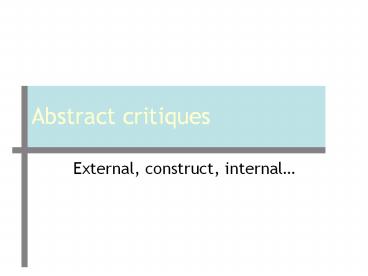Abstract critiques - PowerPoint PPT Presentation
1 / 9
Title: Abstract critiques
1
Abstract critiques
- External, construct, internal
2
Abstract I
- The purpose of this study was to describe the
change in physical fitness of middle-aged adults
with an intellectual disability over a period of
13 years. Participants were 32 adults who worked
in a supported work environment in Montreal and
had been participants in a physical fitness study
in 1983. Using the Canadian Standardized Test of
Fitness, the participants were evaluated for
cardiovascular endurance, muscular strength,
muscular endurance, flexibility, and body
composition. A home visit prior to the testing
session refamiliarized the participants with the
test procedures. Two forms of analysis were used
to describe the change in fitness over 13 years.
First, a 2 x 2 (Group x Time) analysis of
variance for each dependent variable assessed
change over time. Second, effect sizes were
calculated to measure the magnitude of change in
fitness over the 13-year period in comparison to
those without an intellectual disability. As
expected, the physical fitness levels of the
participants were low when compared to those
without a disability and declined over the 13
years. In addition, the magnitude of change over
the 13 years, as compared to those without a
disability, was greater for male and female
participants for body mass index and percentage
of body fat and for female participants for
cardiovascular endurance and sit-ups. It appears
that adults with an intellectual disability may
be particularly at risk for declining health
associated with aging and low physical fitness.
3
Abstract I. External val.
- Population
- middle-aged adults with an intellectual
disability - Sample
- middle-aged adults with an intellectual
disability - who worked in a supported work environment in
Montreal and had been participants in a physical
fitness study in 1983 - in comparison to those without an intellectual
disability. - Setting
- A home visit prior to the testing session
refamiliarized the participants with the test
procedures
4
Abstract I. Construct validity
- Dependent variables
- physical fitness
- cardiovascular endurance, muscular strength,
muscular endurance, flexibility, and body
composition - Canadian Standardized Test of Fitness
- Independent variables
- time, gender, intellectual disability
- Relationship
- Change in physical fitness over time
- Questions
- How well is each construct operationalized? Might
any weakness in the operationalizations alter the
relationship of interest?
5
Abstract I. Internal validity
- Design
- NEGD
- Pre-test Post-test Non-equivalent groups
design, with sub groups for gender - Control over causality
- Temporal precedence, covariance are ok. The
problems stem from lack of control over
alternative explanations - No random assignment, and not clear where other
non-disabled participants are drawn from (social
threats?)
6
Abstract II
- It has been shown in classical strength training
studies using high loads that improvements in
rate of force development are mainly due to
adaptations in the intramuscular coordination.
Adaptations following sensorimotor training were
also characterized by improvements in the rate of
force development during maximum voluntary
isometric contraction. The purpose of the present
study was to investigate neuromuscular
adaptations of combined sensorimotor and
classical strength training. Eighteen subjects
were randomly assigned to two groups. Group 1
(SMT-HST) had to perform a period of sensorimotor
training at first and a high-intensity strength
training afterwards. Group 2 (HST-SMT) performed
the high intensity strength training at first and
the sensorimotor training after. Maximum
voluntary isometric contraction and neuromuscular
activation were measured at three occasions
Before training, after the first, and after the
second period. The results after the first period
confirmed the positive effects of both training
regimen on rate of force development (13
SMT-HST and 27 HST-SMT, p lt 0.05) and on
maximum strength (9 HST-SMT and 12
SMT-HST, p lt 0.05) during maximum voluntary
contraction. Improvements caused by sensorimotor
training could only be achieved, when it was
performed at first. It is supposed that classical
strength training with high loads basically
improves the mechanical efficiency of the
effectors, whereas sensorimotor training alters
the afferent input on the central nervous system.
In combination, the sensorimotor training can
have preconditioning effects on the strength
training. A combination of both training methods
can thus be recommended, if the sensorimotor
training is performed at first.
7
Abstract II. External val.
- Population
- ?
- Sample
- ? 18 participantsno more known
- Setting
- ?
8
Abstract II. Construct validity
- Dependent variables
- Rate of force development
- Maximum strength
- Independent variables
- Time, treatments
- Relationship
- Change in measures of strength as a result of the
2 treatments - Questions
- How well is each construct operationalized? Might
any weakness in the operationalizations alter the
relationship of interest?
9
Abstract II. Internal validity
- Design
- Pretest-post-test, switched replication,
randomized design - Pre-test Post-test Non-equivalent groups
design, with sub groups for gender - Control over causality
- Temporal precedence, covariance ok.
- Random assignment used, so multiple group threats
ok - Switched replications provide some protection
against group threats (no compensatory rivalry)































